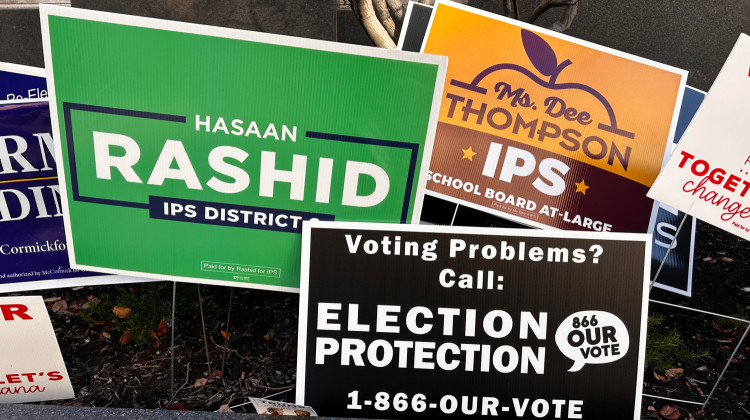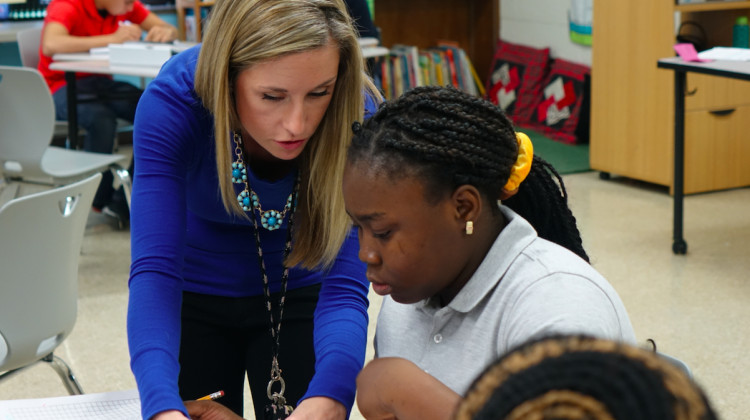
IU student Sarah Fortune received budgeting tips and information on scholarships. She hopes to graduate without debt.
Lindsey Wright/WFIUStudents are faced with big financial decisions early in their college careers, but often they aren’t prepared to do things such as live within a budget, manage debt and understand credit. Early mistakes can have a long lasting impact for these young people.
Universities are taking on some of the responsibility and offering financial literacy programs that aim to help.
Sara Fortune is one of more than 114,000 students enrolled at Indiana University. She works a part-time job on Indiana University’s Bloomington campus and tries to live frugally. But still,there’s a big gap between what she earns each month and what she spends on tuition, books, rent and other expenses
Money is constantly on her mind, and so is her future.
“Being able to graduate with limited debt will better allow me to buy the things I want later in life, so from a house to a car to taking care of kids,” Fortune says.
It’s not easy, though. The number of students borrowing money has nearly doubled in the last decade from 23 million to 43 million borrowers. Rising costs of education, loss of funding, and more people going to college, are some factors in that. However, according to Adam Carroll, author of ‘Winning the Money Game,’ a lot of people with student debt don’t understand how best to decrease borrowing.
“You’d be amazed at the number of students on most campuses that don’t know what a loan is, that they have to pay it back,” Carroll says. “And then you have parents who say, well yeah I signed this thing, it’s a parent plus loan, I just did it so my kid can go to school. And they don’t realize that they themselves have been put on the hook for tens of thousands of dollars.”
Federal laws require that incoming students receive some form of counseling about loans, but it’s often done online so they don’t understand the details of what they’re borrowing.
That’s why Carroll says financial literacy programs designed to help students make informed money decisions should be a requirement at the college level.
“There ought to be one entire course on how much this college costs and what are the borrowing options and what does it mean and how much does this amount correlate to in payment, and what are the 10 money mistakes that every freshman in college makes,” Carroll says.
Schools across the state like Purdue, Notre Dame and Butler offer varying financial literacy tools. One program known as MoneySmarts through Indiana University is proving rather successful. It’s free and IU officials, in part, credit it with reducing undergraduate student borrowing by $70 million since it launched in 2012.
Carroll, along with IU Director of financial literacy Phil Schuman, says the numbers are significant, even more so because they don’t include interest.
“The average [interest] is about $3,200 per undergraduate student, so over the course of their hopefully four years here, they’re borrowing $3,200 less than they were before, which is phenomenal,” Schuman says.
But still, nationally in 2016, the average student loan debt was just over $37,000 . And Shuman says, at IU, the majority of students are in the $15,000 to $25,000 range.
Because of a trip to MoneySmarts, Fortune says she’s on track to graduate with minimal debt, or possibly no debt, thanks to scholarships and budgeting help.
“I initially did it as a part of an assignment,” Fortune says. “But once I actually got here and got to interact with the specialist, I realized that it was more than just a grade.”
When Fortune graduates, she hopes she’ll still be debt free. That’s a much different outcome than many people experience. That’s why Schuman says he encourages students to scroll through the MoneySmarts website. It offers resources, podcasts, quizzes and more.
And experts believe these programs go well beyond just being a student with loans. Carroll says he thinks younger generations are at least thinking about other options, which he says is a good thing.
“So, they’re having these conversations where they’re just trying to educate, and as a result and a byproduct of educating them, the students don’t take on the debt,” Carroll says. “They find other ways, they apply for more scholarships, they do work study, they do a variety of things.”
Carroll says just being aware of the other options can significantly alter what a student’s debt will look like down the road. So far, that is proving true for Fortune.
“In the long run, I think it will help me be a more efficient adult honestly, knowing different ways of managing money,” Fortune says.
Carroll also says another important thing to do is talk to students about finances well before college.
IU recently announced a nationwide program called MoneySmarts U, that will attempt help students at different age levels, even before and after college.
 DONATE
DONATE









 Support WFYI. We can't do it without you.
Support WFYI. We can't do it without you.